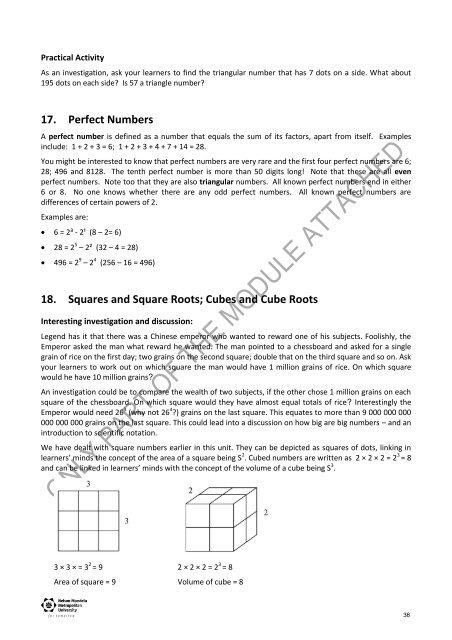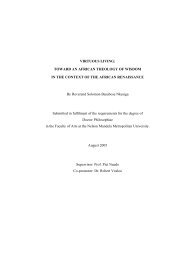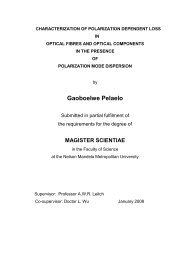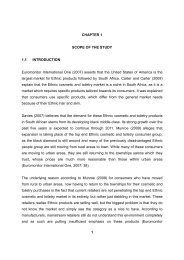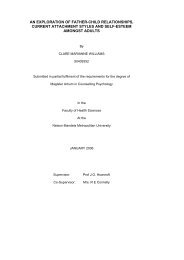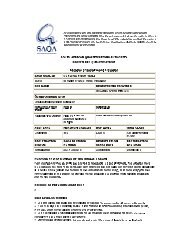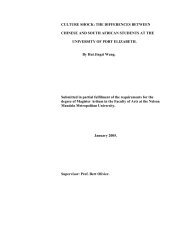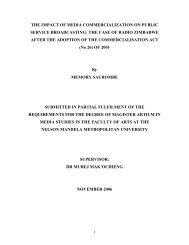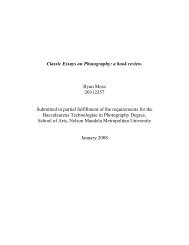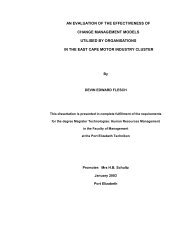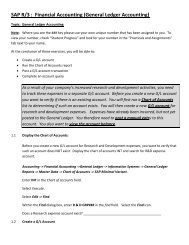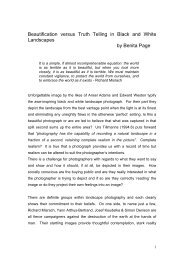concepts and methodology in mathematics education - Nelson ...
concepts and methodology in mathematics education - Nelson ...
concepts and methodology in mathematics education - Nelson ...
You also want an ePaper? Increase the reach of your titles
YUMPU automatically turns print PDFs into web optimized ePapers that Google loves.
Practical ActivityAs an <strong>in</strong>vestigation, ask your learners to f<strong>in</strong>d the triangular number that has 7 dots on a side. What about195 dots on each side? Is 57 a triangle number?17. Perfect NumbersA perfect number is def<strong>in</strong>ed as a number that equals the sum of its factors, apart from itself. Examples<strong>in</strong>clude: 1 + 2 + 3 = 6; 1 + 2 + 3 + 4 + 7 + 14 = 28.You might be <strong>in</strong>terested to know that perfect numbers are very rare <strong>and</strong> the first four perfect numbers are 6;28; 496 <strong>and</strong> 8128. The tenth perfect number is more than 50 digits long! Note that these are all evenperfect numbers. Note too that they are also triangular numbers. All known perfect numbers end <strong>in</strong> either6 or 8. No one knows whether there are any odd perfect numbers. All known perfect numbers aredifferences of certa<strong>in</strong> powers of 2.Examples are: 6 = 2³ - 2¹ (8 – 2= 6) 28 = 2 5 – 2² (32 – 4 = 28) 496 = 2 9 – 2 4 (256 – 16 = 496)18. Squares <strong>and</strong> Square Roots; Cubes <strong>and</strong> Cube RootsInterest<strong>in</strong>g <strong>in</strong>vestigation <strong>and</strong> discussion:Legend has it that there was a Ch<strong>in</strong>ese emperor who wanted to reward one of his subjects. Foolishly, theEmperor asked the man what reward he wanted. The man po<strong>in</strong>ted to a chessboard <strong>and</strong> asked for a s<strong>in</strong>glegra<strong>in</strong> of rice on the first day; two gra<strong>in</strong>s on the second square; double that on the third square <strong>and</strong> so on. Askyour learners to work out on which square the man would have 1 million gra<strong>in</strong>s of rice. On which squarewould he have 10 million gra<strong>in</strong>s?An <strong>in</strong>vestigation could be to compare the wealth of two subjects, if the other chose 1 million gra<strong>in</strong>s on eachsquare of the chessboard. On which square would they have almost equal totals of rice? Interest<strong>in</strong>gly theEmperor would need 26 3 (why not 26 4 ?) gra<strong>in</strong>s on the last square. This equates to more than 9 000 000 000000 000 000 gra<strong>in</strong>s on the last square. This could lead <strong>in</strong>to a discussion on how big are big numbers – <strong>and</strong> an<strong>in</strong>troduction to scientific notation.We have dealt with square numbers earlier <strong>in</strong> this unit. They can be depicted as squares of dots, l<strong>in</strong>k<strong>in</strong>g <strong>in</strong>learners’ m<strong>in</strong>ds the concept of the area of a square be<strong>in</strong>g S 2 . Cubed numbers are written as 2 × 2 × 2 = 2 3 = 8<strong>and</strong> can be l<strong>in</strong>ked <strong>in</strong> learners’ m<strong>in</strong>ds with the concept of the volume of a cube be<strong>in</strong>g S 3 .3 × 3 × = 3 2 = 9 2 × 2 × 2 = 2 3 = 8Area of square = 9 Volume of cube = 838


